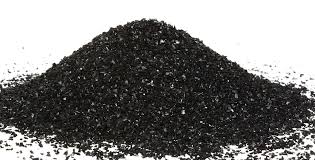Carbon
(GAC)
Adsorption Efficiency of GAC
The trace organic compounds that can be removed by GAC are usually present at µg/liter quantities or less.
Since GAC is used in conjunction with other water treatment processes, the effect of pretreatments for removing trace organic compounds and their precursors were examined in depth.
Hence, the following questions were addressed:
1. How efficiently does GAC adsorb individual trace organic compounds, particularly those of concern to health?
2. When processes such as coagulation, sedimentation, filtration, aeration, disinfection, oxidation, and PAC adsorption precede GAC adsorption, how is the efficiency of the GAC affected?
3. Can water that has been treated by GAC be disinfected more or less easily than water that has not been treated by GAC?
4. What is the potential for effectively using PAC to remove organics?
5. What reactions take place between oxidants that are applied as pre-disinfectants and the activated carbon or the compounds that are adsorbed on the activated carbon? Do these reactions result in potentially hazardous compounds that would not be present if activated carbon were not used?
6. To what extent does competitive adsorption between trace organics with potential health effects and the large concentrations of background organics, generally characterized as humic substances, influence the effectiveness of GAC?
7. To what extent does competitive adsorption among similar concentrations of trace organics with potential health effects influence the effectiveness of GAC?
8. How significant is the effect of competitive adsorption when it is compared to the effect of the re-equilibration that is produced by the variable nature of the composition and concentration of trace organics in the feedwater to the GAC bed?
Removal of Selected Organic Compounds
 Adsorption isotherms and small column studies that are performed in the laboratory using GAC are useful tools that have been developed to describe how specific organic chemicals can be removed in large-scale GAC applications.
Adsorption isotherms and small column studies that are performed in the laboratory using GAC are useful tools that have been developed to describe how specific organic chemicals can be removed in large-scale GAC applications.
A considerable amount of adsorption research describing the affinities of pure compounds for the activated carbon surface has been reported in the literature during the last 15 years.
Improved analytical tools have made it possible both to detect the organics at trace levels in the environment and to follow their removals in adsorption studies in the laboratory.
This section of the chapter evaluates the efficiency of GAC adsorption of individual trace organic compounds, particularly those with potential health effects.
Removals of organic chemicals are discussed in the literature on the basis of laboratory and pilot-scale studies and large-scale applications.
Laboratory studies are by far the most useful for describing specific organic removals since environmental factors can be more carefully controlled in them than in field evaluations.
The problem of competitive adsorption is significant when environmental samples are used in experiments in which specific organic compounds are removed by adsorption.
Adsorption data obtained in the laboratory are normally reported as percent removed, adsorption isotherms, kinetics of adsorption, and the results of small-scale column studies.
In the following sections, these data are reviewed and the utility of each method is evaluated.
Percent Removals
 Giusti et al. (1974) made extensive use of percent reduction as a measure of the effectiveness of activated carbon for removing organic chemicals.
Giusti et al. (1974) made extensive use of percent reduction as a measure of the effectiveness of activated carbon for removing organic chemicals.
They added 93 petrochemicals individually at one level to one type of activated carbon and used the subsequent calculated percent reductions to test several hypotheses concerning the removal of different classes of organics by activated carbon.
There are several problems associated with using percent removal data exclusively to describe how well a particular organic compound is removed from water.
The single value study results in a single point on an isotherm.
Unfortunately, this single point gives no indication of how capacity varies with concentration, i.e., by the isotherm slope and shape.
To be truly representative, the amounts of adsorbed compound per gram of carbon for individual organic compounds must be compared on an equal equilibrium concentration basis, which is not possible if only a single percent removal value is available.
RELATED POSTS:
.
.
CLICK HERE . . .
CLICK HERE . . .
http://puricare.blogspot.com/2016/10/activated-charcoal-or-activated-carbon.html
............................................................................................................................................
............................................................................................................................................
Aganan, Pavia, Iloilo, Philippines
...
CLICK HERE . . . to view company profile . . .
Aganan, Pavia, Iloilo, Philippines
...
CLICK HERE . . . to view company profile . . .
CLICK HERE . . . to view company profile . . .
 |
| Ballast-TypePressure Tank |
 |
| Houston Water Pump with Mazaki Automatic Pump Controller |








No comments:
Post a Comment